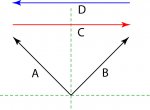120319-0841 EDT
Jim:
With two terminals (two wires) we have a single phase, call it phase A if you want (the naming use of phase).
Within the waveform of this phase we can make measurements of how far one point on the wave is with respect to another point in phase displacement units along the phase axis.
When there are more than two terminals, then more than one phase exists to provide names to identify these different sources.
Two or more of these phases might be identical and thus their waveforms would exactly coincide with each other. These phases would be described as "in-phase" or "same phase".
By general usage waveforms that are identical except for an amplitude difference are also described as "in-phase". Note amplitude is only a positive number.
When waveforms that share the same period (frequency) are different in shape, then there has to be a definition of what point on each waveform is the reference point for making comparisons between the waveforms. When comparing two sine waves one might pick the positive peak, and a sine wave with a sawtooth also might use the positive peak of each. Also the positive slope zero crossing is a popular choice. A sine wave compared to a square wave would most certainly use a defined slope and zero crossing because there is no unique maximum positive point for the square wave.
In normal usage, as we have shown in many different references, a sine wave and its inverse or 180 degree shifted wave are not "in-phase" or of the "same phase".
Anyone that is really familiar with circuit analysis will not classify VAN and VBN of a center tapped secondary as being "in-phase".
.


